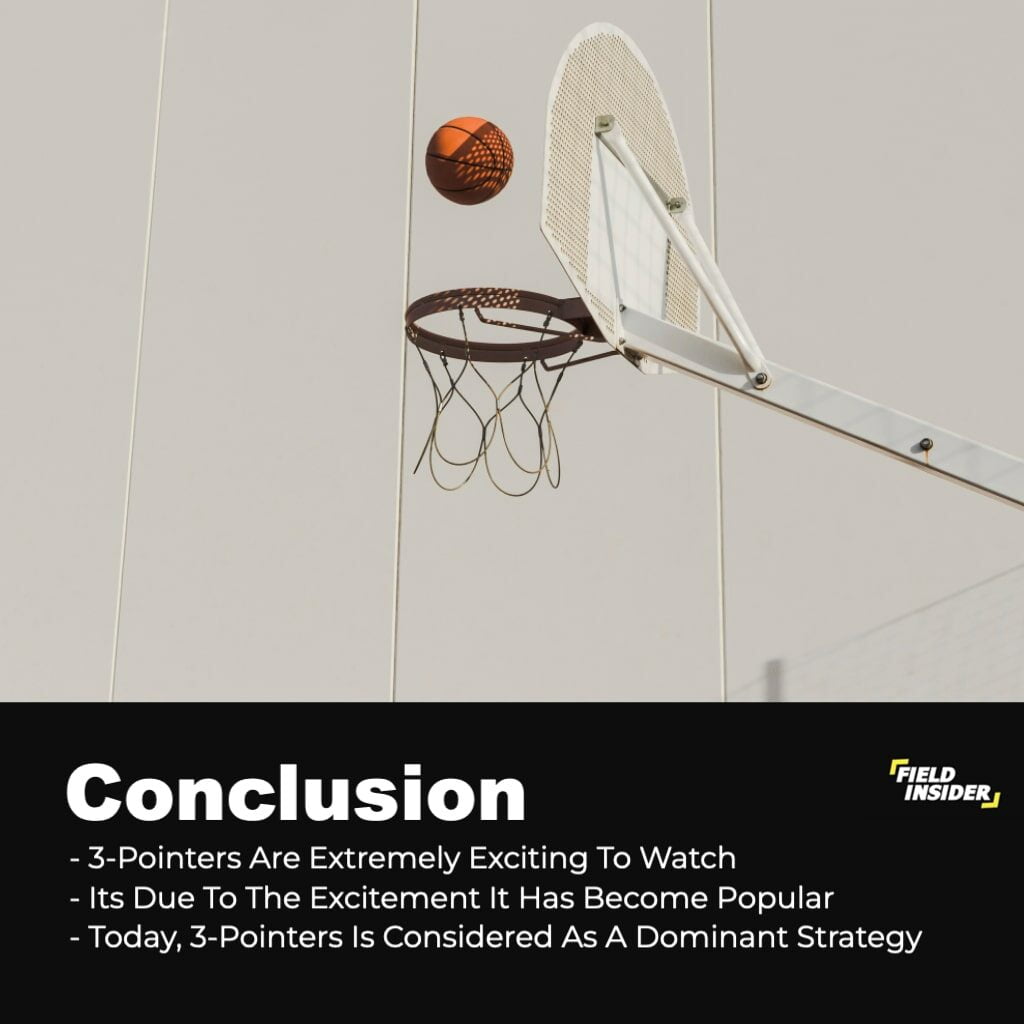The 3-Point Line: How It Changed The Game Of Basketball
The 3-point line is a relatively new rule in the game of basketball. It was created by the American Basketball Association to make games more exciting and increase scoring. The 3-point line has done just that, as it’s helped to revolutionize the game. This blog post will discuss what 3-point lines are. When they were introduced. How they changed the game of basketball, and why you should care about 3-points during this year’s NBA playoffs!
Why was the 3-Point Line Invented?
The 3-point line was introduced to the NBA to help increase scoring and excitement during games. It’s helped lead to a more explosive game with higher scores.
The 3-point line in basketball was invented to incentivize players to shoot from farther away from the basket, thereby creating more opportunities for long-range shots and increasing the scoring possibilities of the game.
The introduction of the 3-point line also aimed to encourage more strategic and varied gameplay, as teams could now incorporate more outside shooting into their offensive strategies. As we see teams average 117 points per game today compared to just 93 back when there wasn’t a 3-pointer!
This is why you should watch out for 3 pointers this year during the playoffs. They’re worth so much now that it can change an entire playoff series if one team starts hitting 3 after 3. While their opponent struggles from behind the arc.

Who Came Up with the 3-Point Line?
As different leagues and organizations started experimenting with regulations and scoring systems to make the game more thrilling and dynamic in the early 20th century, that is when the 3-point line in basketball first appeared. But, the concept of a 3-point line didn’t start to take shape until the 1960s.
A 25-foot “3-point circle” was adopted by the American Basketball Association (ABL) in 1961, and players were awarded three points for jumpers made from beyond that line. The ABL only lasted one season, therefore its trial with the 3-point line was short-lived.
The American Basketball Association (ABA) experimented with a 30-foot 3-point line in the late 1960s and early 1970s, and it eventually became one of the league’s distinguishing characteristics. In addition to being wider than the ABL’s, the ABA’s 3-point line awarded players three points for shots taken beyond it. The ABA’s use of the 3-point line helped set it apart from the NBA and draw spectators to its fast-paced, high-scoring brand of basketball.
Initially leery of the 3-point line, the NBA subsequently started experimenting with it in the late 1970s. The 3-point line was originally used by the NBA in 1979, and it was set at the same 23-foot, 9-inch distance as the ABA’s line. Since then, players and coaches have developed new plans and approaches to take advantage of the 3-point line’s scoring potential, making it an essential component of the game. Over the years, the NBA has also changed the 3-point line’s location, bringing it back to its present locations of 22 feet in the corners and 23 feet, 9 inches everywhere on the court.
The 3-Point Line in the NBA
The 3-point line has gone through some changes since it was first introduced in 1979. It moved originally from the middle of the court to halfway between, before moving back to its current position (the corners) in 1984.
Before 1979 3 point shots were rare and teams scored an average of 79 points per game. But after 3 pointers became commonplace scoring increased by almost 20 points! The NBA knew that 3’s would be a key part of their game as they expanded into new markets like China.
Where people already had more exposure to 3-pointers than ever before. There are now 30 teams competing for 12 playoff spots each year – so watch out for those threes!
Getting the Best From the 3-point Line
Basketball teams have adjusted their strategies with 3-point shots being a viable option. As more and more players become capable 3-pointer shooters.
Coaches are changing the way they approach games by taking advantage of open 3’s around the perimeter. Players who once had to work hard for mid-range or close-up baskets. Now sit on the perimeter as spot-up shooting threats that must be defended at all costs!
In some cases, it has been even seen as beneficial to intentionally foul 3 point shooters. So you can get back possession of your basketball! While this may seem counterintuitive, fouling from behind away from shot attempts means there is no chance of them scoring from those spots.
Thus allowing your team to score before halftime ends (and potentially giving you possession of the ball)!

The Differences between the NBA 3-Point Line, and the College 3-Point Line
Many fans of college basketball may be surprised to learn that 3-point shots are worth more in the NBA than they are at their alma mater. So why is this?
One major reason for the 3 point line being different between NCAA and NBA standards can be explained by how many 3 pointers were taken during each league’s respective games! Since 3 pointers weren’t as widely used. A lot more mid-range jumpers flooded NCAA play.
Meaning it was harder for offensive players to score from behind the arc. In fact, before 2008 there wasn’t even a 3 point line on any of the three levels of competition (Pro/College/High school)!
Since 3 points didn’t matter much back then though. Teams only averaged around 60 3-pointers made per season across the board. This meant 3 point shooters weren’t necessarily valued as highly. And teams could field players that were smaller but more athletic because their 3 pointers weren’t expected to carry them!
Here’s a table showing the differences between the NBA and college 3-point lines:
| Charateristic | NBA 3-Point Line | College 3-Point Line |
|---|---|---|
| Distance | 22 ft (corner) 23 ft 9 in (elsewhere) | 22 ft 1¾ in |
| Arc Length | 63.65 ft | 66 ft |
| Backboard Distance | 3.5 ft | 4 ft |
| Rim Height | 10 ft | 10 ft |
Note that the distance from the basket is the most significant difference between the NBA and college 3-point lines. While the NBA line is shorter in the corners, it is longer at the top of the arc and elsewhere on the court. The arc length, backboard distance, and rim height are all the same for both the NBA and college 3-point lines.
This explains why the NBA is more spread out and why some international players like Luka Doncic and Nikola Jokic say it’s easier to score in Europe than the NBA. The FIBA rules have a shorter 3 point range which means more peopl are clogged inside the paint.
Then vs Now
However recently you can see a change in this trend, especially at the collegiate level where 3 pointers are worth an extra .44 points compared to what they’re worth in today’s NBA games! But why is there still such a large difference between NCAA 3-point line standards?
Well, it turns out college basketball has always been different. Since its inception, there wasn’t even any mention of having a 3 point shot until 1996. When FIBA was first introduced for international play (and only then did we start seeing similar scoring rates)!
As 3-pointers became more common to FIBA rules, NCAA 3 point lines were created in the same years as international 3 point shots.
Even though 3 pointers are worth one whole extra point at all levels of college basketball now – players still aren’t shooting many threes! In fact, during the 2017/18 season, only 34% of points scored came from behind the 3 pt line.
This means that even if you have a great 3 point shooter on your team, they’re likely taking less than half their total number of field goal attempts from long range!
Why is the 3-Point Line So Important in the NBA?
The 3-point line has changed the game of basketball.
It used to be a novelty, but it’s now a must-have in every team’s arsenal. 3 pointers are worth 3 points while any other shot is only worth two – that difference can end up being crucial during playoff time when sudden death overtimes and championship games could easily come down to just one or two 3s!
For teams to win NBA games, the 3-point line is crucial because it gives them a chance to score more points with a single shot. Teams that can shoot the ball well from beyond the arc can score points more effectively and rapidly than those that rely on 2-point shots since a 3-point shot is worth more than a 2-point shot.
The 3-point line can also widen the court and give players more room to maneuver. Defenses are compelled to cover 3-point shooters more closely when a team has numerous players who pose a danger, which can open up spaces for other players to drive and score. This is particularly true in the current NBA, where a greater number of “stretch” players—players who can shoot from outside and spread the floor—have emerged as a result of the focus placed on 3-point shooting.
Moreover, the 3-point line can alter a game’s momentum. A team and its supporters can be energized by making a string of 3-pointers, while a team’s confidence can be damaged and their opponents’ advantage can be given by missing 3-pointers.
In addition, teams who struggle from behind this arc may find themselves at a disadvantage compared to their opponent if they don’t change things up soon! The 3 point line was created for excitement and higher scores, but today we see players taking shots from even further out than ever before – leading us into our next topic…
The Best 3-Point Shooters

Stephen Curry
Stephen Curry is the 3 point king of this decade. He has won 3 NBA Championships (two back-to-back) and holds various 3 point shooting records like most career 3 pointers made. The highest-scoring game containing only 3 pointers, etc.
Curry was also an extremely high scorer in college too. Where he played for Davidson before being drafted by the Golden State Warriors! During his time at Davidson, Stephen averaged 28 points per game. While making more than 100 three-pointers during each season with them!
Steph Curry has revolutionized the game with his 3-point shooting ability. He is a three-time NBA champion and two-time MVP who has shattered numerous 3-point shooting records. As of today, Curry is 1st on the NBA’s all-time list for made 3-pointers with 3,367, and he has shot an incredible 43.3% from beyond the arc for his career. That’s essentially 4 three-pointers made per game in his whole career.
Ray Allen
Ray Allen, now the second-best 3 point shooter of today’s game. He has played for both college and professional teams, but he was most known during his time at UConn where he won two national championships.
During Ray’s career in the NBA, he averaged around 3 three-pointers made per game – even though that number dropped to less than one during his last year with Miami! Unfortunately, Ray retired because of injuries after 19 years in the league.
Klay Thompson
Klay Thompson is one of the greatest 3-point shooters of all time, with a career 3-point percentage of 41.9%. He is a five-time All-Star and three-time NBA champion who has made 2,197 3-pointers in his career. Thompson is known for his quick release, accuracy, and ability to catch fire from beyond the arc.
Thompson is also a prolific 3-point shooter, consistently ranking among the league leaders in 3-pointers made. He has made over 200 3-pointers in a single season six times, which is tied for the second-most in NBA history.
Thompson is known for his ability to make big shots in important moments. He has hit several game-winning and series-clinching shots in his career, including his 11 3-pointers in Game 6 of the 2016 Western Conference Finals to help the Warriors come back from a 3-1 deficit and advance to the NBA Finals.
James Harden
James Harden, the 3-point assassin. He’s currently playing for New York Nets where he leads his team in 3-pointers made per game and 3-point percentage!
Throughout James’ career in the NBA, he’s averaged 3 3-pointers per game – with a total of 2400+ made during his time in Houston Rockets, Oklahoma City Thunder and the New York Nets! Harden has also played on USA Basketball Team where they won gold at both the 2014 FIBA World Cup and the 2016 Rio Olympics.
James was named MVP for two consecutive seasons (2015/16 & 2016/17) while leading all players with 119 points scored throughout these playoffs!
Reggie Miller
Reggie Miller, the 3-point shooting legend. He played exclusively for the Indiana Pacers during his career in the NBA, where he made more 3 pointers than anyone else has ever done, for the Pacers!
During the first years of Reggie’s playing days, no one-shot them better than him. He finished with a career total of 2560 3-pointers throughout 18 years of being an active player on professional teams.
In addition to leading all players with 50+ three-pointers made consecutively throughout 3 seasons (1993/94 through 1995/96), Reggie also has 5 All-Star appearances.
Unfortunately, injuries forced Reggie’s retirement after years of being a top 3 point shooter in the league!

Conclusion
3-pointers are extremely exciting to watch, and it’s clear why they became so popular among the fans of this game. 3 point shooters like Stephen Curry, Ray Allen, and Reggie Miller have become legends in their own right for scoring 3 pointers with ease – helping them win games along the way!
Today, we see 3-point shooting take over as one of the most dominant strategies that teams can play when competing against each other on a professional basketball team.
Thanks for reading this blog post about how the 3-point line changed basketball forever. We hope you enjoyed it as much as we did writing it!








